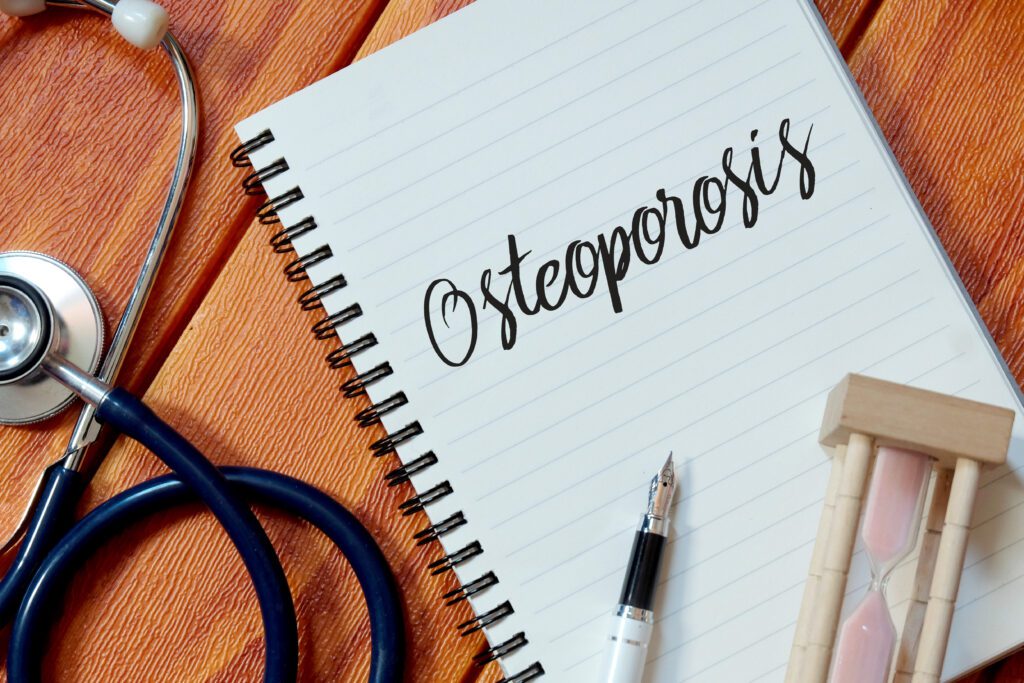

As we get older, there’s an increased risk of developing osteoporosis and osteopenia. While it’s more common in women, men are not immune to developing osteoporosis. It’s estimated that 50% of women and 25% of men will suffer a fracture due to osteoporosis.
Fortunately, you can help prevent and even reverse the effects of osteoporosis. Learn more about how Bioidentical Hormone Replacement Therapy (BHRT) can help prevent and treat osteopenia and osteoporosis.
What is Osteoporosis?
Osteoporosis is a condition that develops when your bones begin to lose bone density. In other words, your bones become brittle and weak. In fact, the term “osteoporosis” comes from the Greek term for “porous bone.”
Types of Osteoporosis
There are two types of osteoporosis:
- Primary Osteoporosis: This type of osteoporosis occurs after menopause (postmenopausal osteoporosis) or from aging (senile osteoporosis).
- Secondary Osteoporosis: This type of osteoporosis is caused by various disorders such as cancer, eating disorders, endocrine disorders, or kidney disorders and can also develop as a side effect of drugs or medications.Related to osteoporosis is osteopenia, which means your bone density is lower than normal but not so low that you’ve developed osteoporosis.
Effects of Osteoporosis
When you develop osteoporosis, you’re at an increased risk of a fracture, even from minor trauma such as bending over or coughing. These fractures are most common in your hips, spine, or wrists and can lead to a decreased quality of life or disability. Even though the risk for fracture with osteopenia is not as high as with osteoporosis, left untreated, osteopenia can develop into osteoporosis.
Risk Factors for Developing Osteoporosis
There are several risk factors for developing osteoporosis, including:
- Aging. The older you get, the higher your risk of developing osteoporosis.
- Bone structure. People with smaller, thinner frames are at a higher risk of developing osteoporosis.
- Gender. Women are more likely to develop osteoporosis than men.
- Family history of osteoporosis
- Lifestyle choices. Smoking drinking too much alcohol, and not being physically active can significantly contribute to bone loss.
- Lack of vitamin D in your diet, which helps maintain your calcium levels. –
- Medications i.e. corticosteroids
However, aging is one of the most significant risk factors because most people who develop osteoporosis and osteopenia are over 50.
And here’s why: declining hormone levels.
The Role of Hormones in Bone Density
Two hormones help us maintain our bone density: Estradiol and testosterone. And while testosterone is most often associated with men and estradiol with women, it turns out the levels of both hormones play a significant role in bone density levels in both sexes.
This is because of an enzyme called aromatase, which converts testosterone into estradiol in both men and women. If testosterone levels are low, estradiol levels will be low as well.
Estradiol, also known as E2, is paramount in maintaining bone health. In short, it helps balance our bones’ normal breakdown and rebuilding cycle, specifically by slowing down the breakdown process. But when your estradiol or testosterone levels are low, bones are at a greater risk of losing their mineral density.
A recent study showed that bone loss caused by E2 deficiency follows an expected sequence:
- Initially, there is rapid bone loss, particularly in trabecular bones. These are porous bones composed of trabeculated bone tissue found at the ends of longbones like the femur.
- The loss in bone density of a trabecular bone is 5-8% every year
- Compact or cortical bones may decrease by 1-3% each year.
- Once 10-15 years of E2 deficiency have occurred, the rate of bone loss will begin to decrease, but by then, your skeletal mass can be 33-50% less than it was initially.
Another study revealed that men with testosterone deficiency syndrome (TDS) are at a greater risk for low bone density, with testosterone replacement therapy indicated for men with TDS and osteoporosis. Yet another showed the correlation between testosterone levels and bone mineral density in females.
How We Test for Osteoporosis
Osteoporosis is often a “silent disease” due to a lack of symptoms. Without proper testing you are at risk for developing osteoporosis, you may not know you have it until you fracture a bone.
Fortunately, a specialized low-radiation x-ray called a DXA scan can measure your bone density to help determine how much bone loss has occurred, if you have osteoporosis, and predict your future risk for fractures.
However, many men are often not screened with a DXA scan, even when they have low testosterone levels. As discussed above, estradiol levels will be low if testosterone levels are low, indicating a risk for lower bone mineral density.
How Bioidentical Hormone Replacement Therapy Can Help with Osteoporosis
Hormone replacement therapy can help prevent and treat osteoporosis. High calcium intake, as traditionally indicated for preventing osteoporosis, without estradiol has been proven ineffective in preventing accelerated bone loss in postmenopausal years. Long-term studies confirm that postmenopausal women who regularly use estradiol have greater bone mass and fewer osteoporotic fractures.
While synthetic estrogen therapy was once well-received and widely used to combat osteoporosis, long-term results proved that synthetic hormones sometimes elicit a negative metabolic response.
That’s because synthetic hormones are not biologically identical to human hormones and are foreign to our bodies, potentially causing dangerous side effects.
Thankfully, Bioidentical Hormone Replacement Therapy (BHRT) can help prevent, treat, and even reverse the effects of osteoporosis.
Bioidentical hormones are natural hormones and come from plants such as wild yams or soybeans. Therefore, the body can utilize them as they are natural to our body.
Long term studies demonstrate that postmenopausal women who regularly use Estradiol have greater bone mass and few osteoporotic fractures. Bioidentical hormone optimization is key, and a highly trained provider is essential.
Expert Hormone Optimization with Rejuvenate Hormone and Weight Loss Center
At Rejuvenate Hormone and Weight Loss Center we specialize in hormone optimization and helping people find their root cause of their health issues – we don’t believe in a one-size-fit-all approach to treatment.
Instead, we take the time to understand your symptoms and medical history and work with you to create a personalized treatment plan specific to your healthcare needs. Our bio identical hormone replacement therapy specialist are experts at helping you achieve optimal health.
Our concierge practice is a safe, supportive place to call home and receive real-time expert support- in person or virtually –for all your health goals and challenges.
Contact us today for a consultation where our team of providers will formulate an individualized treatment plan to help you feel and look your best–from the inside out. Feeling like yourself again and living your best life starts here an now.
Book a consultation today to get started!!
The information provided is for informational or educational purposes only and does not substitute professional medical advice or consultation. Please work with a qualified health care provider before starting any new medication or supplements.


